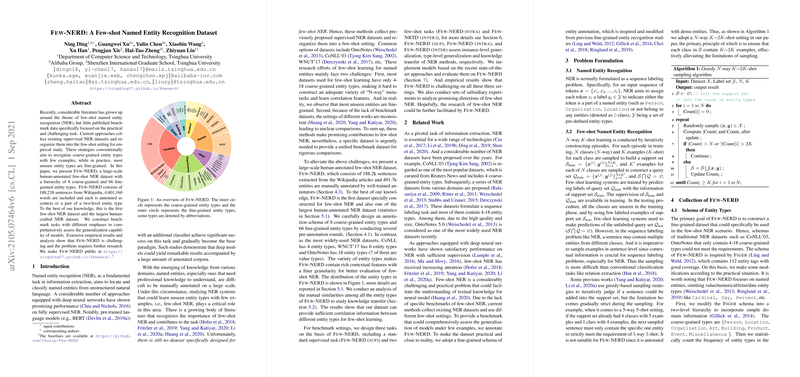Few-NERD: A Few-shot Named Entity Recognition Dataset
The paper introduces Few-NERD, a significant contribution in the domain of Named Entity Recognition (NER), specifically tailored for the few-shot learning paradigm. Few-shot learning, a subset of machine learning, aims to train models effectively with a limited number of examples. Few-NERD addresses this challenge by providing a comprehensive and meticulously curated dataset, enriched with both coarse-grained and fine-grained entity types.
Dataset Composition and Design
Few-NERD spans 188,238 sentences sourced from Wikipedia, encompassing 4,601,160 words. Each word is annotated at two hierarchical levels: 8 coarse-grained and 66 fine-grained entity types. This dual-layered architecture is pivotal in facilitating the recognition of both broad and nuanced entity types, a gap often left unaddressed by traditional datasets. The dataset's scale and strategic design arguably make it one of the largest and most granular contributions to the NER community, specifically targeting the few-shot learning context.
Challenges Addressed
The paper identifies notable challenges prevalent in the few-shot NER domain. Traditional datasets are re-purposed into few-shot settings but often lack the granularity needed to effectively train models on unseen, fine-grained entity types. Few-NERD mitigates this issue by incorporating a diverse set of entity types, thus ensuring a more comprehensive training framework for model generalization.
Benchmark Tasks and Experimental Evaluation
Few-NERD introduces three benchmark tasks: Few-NERD (sup), Few-NERD (intra), and Few-NERD (inter). Each task serves to evaluate different dimensions of model generalization:
- Few-NERD (sup): A standard supervised NER task, providing a broad overview of instance-level generalization across all entity types.
- Few-NERD (intra): This task assesses type-level generalization, isolating entity types within different coarse-grained categories, thereby testing models on type discrimination without prior exposure.
- Few-NERD (inter): Here, knowledge transfer is evaluated. The task tests cross-type generalization where entity types within the same coarse category share underlying semantics, thus focusing on coarse-level correlations.
The paper employs models such as BERT-Tagger, ProtoBERT, NNShot, and StructShot to establish baseline performances across these tasks. The empirical results clearly indicate the complexity and challenge posed by Few-NERD, as these state-of-the-art methods attain significantly lower performance compared to standard NER datasets.
Implications and Future Directions
Few-NERD stands as a formidable asset in the landscape of NER datasets due to its meticulous design and emphasis on few-shot learning. Its implications are far-reaching; it provides a rigorous benchmark aiding in the development and refinement of models that can adapt to new, unseen data with minimal supervision. This characteristic is particularly beneficial in fast-evolving domains where annotated data is scarce.
Future work could explore extending the dataset's utility by incorporating cross-domain annotations or even finer-grained hierarchies. Additionally, Few-NERD sets the stage for advancing continual learning paradigms within NER, paving the way for models that dynamically evolve with increasing data complexity.
In conclusion, Few-NERD is a substantial contribution to the NER and few-shot learning communities, offering a robust platform for the development of adaptable and resilient models. The dataset not only addresses present limitations but also anticipates future needs in AI and machine learning research.
